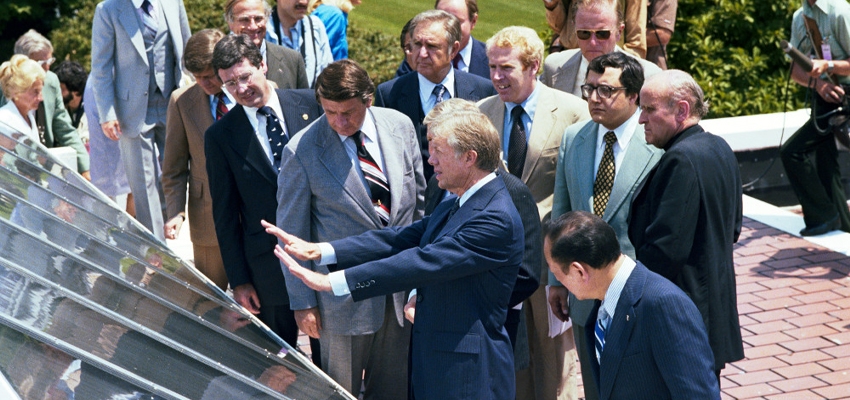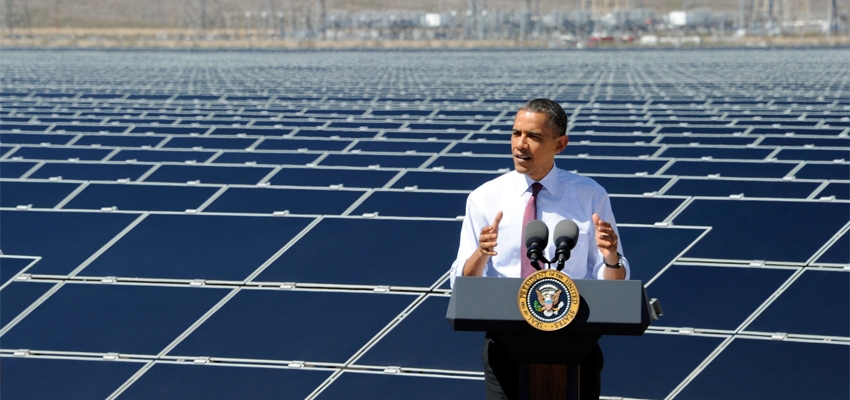On a June day in 1979, Jimmy Carter unveiled 32 thermal solar panels perched atop the roof of the West Wing of the White House. The setting was perfect – the sun was shining as the press came out to document this momentous occasion. These are arguably the most famous solar panels ever installed.
Even Jimmy Carter recognized the historic nature of the solar panels, as he remarked at the time how generations would see the panels as “a curiosity, a museum piece” or “a small part of one of the greatest and most exciting adventures ever undertaken by the American people.” And, Carter was right, some of his White House solar panels are now museum pieces.
Energy crisis and new policies

In the 1970s, the United States saw two oil crises, which led to tighter energy supplies and higher oil prices. On August 4, 1977, during the presidency of Jimmy Carter, a new energy policy was created in response to the first energy crisis, which was caused by the oil embargo. This included energy conservation and the research and development of renewable energy sources, especially the development and use of solar energy. At the same time, President Carter signed the Department of Energy Organization Act, which set up the Department of Energy.
Carter installed a solar heating system for the White House laundry and pool. The system cost about $280,000 to install, which was a lot of money at the time. But Carter saw it as an investment in the future of energy technology and an inspiration to the American people. While solar panels are technically an improvement, they may be more politically symbolic than practically useful. Through this action, President Carter hopes to encourage the American people and businesses to adopt solar technology and reduce their dependence on fossil fuels.
President Ronald Reagan removes Carter’s solar panels
Carter realized that his new energy policy would be strongly opposed by the oil industry and could be reversed by a succeeding president. As it turned out, although Carter's solar panels remained on the White House roof for seven years, they were eventually removed and never reinstalled.
In 1980, Carter lost the presidential election to Ronald Reagan. The Reagan administration came to power critical of Carter's policies, including support for solar energy, and in 1986 the White House solar panels were removed, officially citing high maintenance costs and system inefficiencies.
After their removal, they were stored in a warehouse in Virginia and virtually forgotten. The Reagan administration also allowed Carter's solar incentives to expire while his solar panels gathered dust in Virginia. Today, however, solar power is widely available in all states (solar in Pennsylvania, for example) and users get special discounts.
Where did these solar panels go?
After spending five years in Virginia, the used solar panels traveled to Unity College in Maine, as a publicity stunt to bring attention to the college’s environmental education mission, where they remained for decades.

But thermal solar panels are full of water and plumbing and don’t last forever. And solar panel technology has come a long way since then and is much more efficient than these older designs.
Unity College used the panels until 2005, with one later becoming a part of the Smithsonian’s National Museum of American History located in Washington, D.C, a little more than a mile from their original spot on the White House roof.
One was sent to the Jimmy Carter Library and Museum in Atlanta and another to the Solar Science and Technology Museum in Dezhou, China. Another of these used solar panels is on display at the Vermont headquarters of NRG Systems, as a testament to Carter’s vision for a sustainable future.
Solar panels return to the White House
For decades after the solar panels were removed, no new solar panels were installed at the White House. It wasn't until 2003 that George W. Bush quietly installed a 9-kilowatt solar system on the grounds maintenance building. He also installed two solar thermal systems at the White House, one to heat the spa and one to heat the swimming pool.
While not as ambitious or widely publicized as Carter's solar panels, it's a step toward a more energy-efficient White House.
The environmental organization 350.org launched the "Put Solar On It" campaign in 2010 to encourage the reinstallation of solar panels at the White House, and in 2013, during Barack Obama's presidency, the White House announced that it had reinstalled solar panels. This time, modern photovoltaic panels were installed to generate electricity, rather than the solar collectors of the Carter years. These new solar panels were installed on the roof of the White House as a symbol of America's commitment to renewable energy.

In September 2010, a group of students from Unity College presented White House officials with one of President Carter’s used solar panels to commemorate the administration’s solar initiative.
Your home may not be the White House, but the value of producing clean energy has never been greater. If you're ready to install solar panels on your home or business, contact a solar professional or contact us directly and PowerHome will help you determine the best installation for your needs.
(1).png)
(1).png)